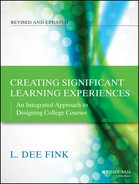ACKNOWLEDGMENTS
To paraphrase a modern aphorism, “It takes a village to write a book.” That has never been more true of a book than of this one. A very important part of my village consists of the other people who have written about college teaching. The key ideas presented here build on a number of classic works in higher education and incorporate exciting ideas from several contemporary publications. A quick look through the text, the list of references, and the suggested readings in Appendix B will illustrate how deeply my own education is indebted to the published works of others.
Others have contributed in an even more direct fashion. Although the questions and ideas presented here have been brewing for many years, several insights crystallized in 1996 when I was teaching a course titled “Instructional Strategies in Adult and Higher Education” at the University of Oklahoma. The response of the graduate students in that class prompted me to undertake an intense journey of searching, reading, creating, discussing, testing, and revising ideas.
Along the way, a number of individuals were instrumental in furthering that journey. Steve Paul, an exceptional music educator then at Oklahoma and later at the University of Arizona, pushed me in a series of conversations that lasted a year and a half and resulted in the initial outline of the key ideas presented here. Bill McKeachie, the person who more than anyone else legitimized scholarly work on college teaching, provided important encouragement during the early stages of this journey, a time when I was unsure about the worth of the ideas and my own ability to put them in book form. Tom Angelo generously took time from a very busy schedule to read an early draft and pointed out some needed changes.
During the last few years, faculty members at my own institution and elsewhere have listened to these ideas in informal conversations and in formal workshops. Although this is a task that never ends, their response has brought me a long way toward understanding what needs to be said to make these ideas meaningful to people who care about teaching and who want to teach well. One faculty member in particular, John Furneaux, a physics professor at Oklahoma, not only listened but also offered his own course as a lab for testing the worth of the ideas. The results of that experiment are shared in Chapter Five.
I also wish to pay tribute to two people who served as mentors to me at various times early in my life: Thomas Ludlum and William Pattison. Both of them modeled a level of intellectual and humane excellence that has served as a guidepost throughout my personal and professional life.
Lynn Sorenson, formerly at Oklahoma and now associate director of the Faculty Center at Brigham Young University, generously gave of her time and expertise in suggesting changes that made this book more coherent and readable.
Finally, I must mention the influence of Arletta Knight, who also works in the field of instructional development and who has given me marvelous feedback on multiple drafts of the manuscript. She offered continual moral encouragement and extremely valuable suggestions on changes that would help the book make better sense to others. I am extremely fortunate to have such a person in my life—and to have such a person as my wife!
